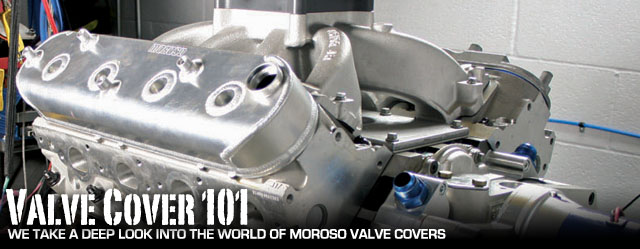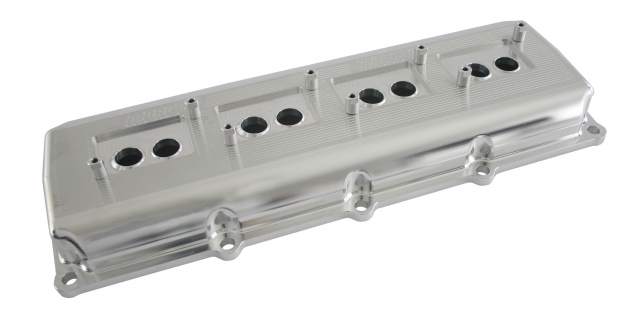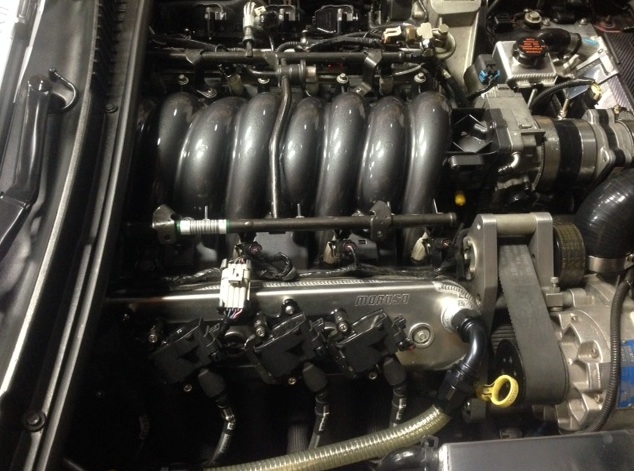 When it comes to engine parts, they don’t get much more basic than the valve covers. More accurately called rocker covers, their only function up until just recently was to shield the valve springs and rockers from dust and debris, and contain the oil that’s flinging around in there when the engine is running. Valve covers are not under any stress so historically they’ve been made out of simple stamped steel. But like anything, the more serious the engine gets, the more design changes may be needed in the valve covers.
When it comes to engine parts, they don’t get much more basic than the valve covers. More accurately called rocker covers, their only function up until just recently was to shield the valve springs and rockers from dust and debris, and contain the oil that’s flinging around in there when the engine is running. Valve covers are not under any stress so historically they’ve been made out of simple stamped steel. But like anything, the more serious the engine gets, the more design changes may be needed in the valve covers.

It’s hard to beat the clean, racy appearance of fabricated covers on an LS engine. These covers have the mounting bosses for the coils welded into the covers. Moroso does indeed have a welding robot, but the robot is not used to weld valve covers—it’s used on oil pans to cut each sump the same way every time. When we asked them about the robot working on valve covers, Moroso’s National Sales and Marketing Manager Thor Schroeder said, “At the present time with the technology that is out there, with the different part numbers and variation of part numbers, and the fact that Moroso makes a very conscious effort with every project to keep fellow skilled American Craftsmen employed, we don’t think the human touch can be beat.”
At a basic level, a hot rodder would only change valve covers for appearance’s sake. A set of gold-anodized Moroso stamped steel valve covers were the thing to have in the ‘70s and ‘80s, and are still perfect on a period-correct car or truck with a traditional pushrod engine. Also popular were the ribbed Mickey Thompson/Holley covers, and later there were custom valve covers from all kinds of manufacturers. Swapping valve covers was the easiest and least expensive way to liven up an otherwise boring engine compartment.
Fast-forward to today and you have thousands of options when it comes to valve covers, and some of them are necessary modifications over stock. One of the earliest uses for custom covers came with the addition of stud girdles, which link the rocker studs together and prevent valve train flex. These girdles require more room vertically than stock valve covers could provide, so the aftermarket, most notably Moroso, built taller covers.
As the automotive aftermarket grew, different materials and processes came into use, including valve cover manufacturing. The basic stamped steel that has been used since day one was still the most popular means of construction, but also on the scene were cast aluminum, and later covers made out of hand-fabricated sheet metal and billet aluminum.

Performance valve train components sometimes require taller-than-stock valve covers for clearance. Compare the first photo above with this shot of Moroso’s tall cover for a small-block Chevy, which Dick Moroso created back in the 1960s.
But perhaps the most significant change to valve covers in recent years is the introduction of coil-on-plug engine designs, like as the GM LS-series engines. This arrangement mounts the coils directly to the valve covers, which necessitates an obvious design change in the cover. And let’s face it, modern engines are kind of ugly, so a valve cover swap is still one of the best ways to pretty an engine up.
So let’s cover the four basic methods of construction when it comes to valve covers and go over the pros and cons of each.
Moroso History at a Glance
Dick Moroso was a winning modified production drag racer in the ‘60s, and started the company bearing his name in 1968. Moroso pioneered many racing products including deep-sump oil pans, electric water pumps, tall valve covers, lightweight front drag tires, racing vacuum pumps, and others.
In November 1998, while the company was celebrating its 30th anniversary, Dick lost a year-long battle with cancer, leaving the company in the hands of his son Rick. Based in Connecticut, they manufacture over 4,000 products for the performance enthusiast.
These are the most common types of valve covers and were supplied from the manufacturers on their production engines. According to Schroeder, “Stamped steel covers are the most cost effective for a manufacturer, but are only feasible if it is a for a very popular cylinder head due to the tooling cost. Plus, inferior designs can be very hard to seal at the gasket surface.” The drawback is that the steel is very thin, which can warp under excessive bolt torque, making these covers difficult to seal at the gasket. In other words, they tend to leak oil if tightened down too hard.
Cast Aluminum
Cast aluminum covers are a little more expensive than stamped steel. Similar to stamped, because of the tooling costs involved cast covers are also only feasible for a manufacturer if it is for a very popular cylinder head. That rules out cast aluminum and stamped steel for exotic cylinder heads or the latest and greatest cylinder heads until there is enough demand. They are also a little heavier than stamped steel, which can be a concern on big-block Chevys or Chrysler Hemis.
Fabricated

Though these are not LS valve covers, Moroso’s billet covers for the late-model Chrysler Hemi shows how they can create engine jewelry with the CNC machine. What starts off as a 34-pound chunk of billet aluminum ends up this 4-pound valve cover with a precision flat surface for superior sealing. Airtight sealing also allows the engine to pull greater vacuum for improved ring seal and power
Moroso’s fabricated valve covers have a billet aluminum rail for the gasket-sealing surface with sheet aluminum welded to the rail. This type of production method lends itself to being able to be able to do smaller production runs on cylinder heads that are more specialized. “The construction of fabricated valve covers allow the manufacturer to accommodate customer requests for custom heights, notches for chassis restrictions, addition or subtraction of fittings, and other non-standard modifications,” added Schroeder.
Billet Covers
Everyone loves billet, right? Billet valve covers look cool and seal like gangbusters, but they are expensive to manufacture from a material and CNC machine-time standpoint. For example, each one of Moroso’s single big-block Chevy billet valve covers starts out as a 60-pound billet bar that is machined down to around 3.6 pounds. Similarly, each one of Moroso’s single Chrysler 5.7/6.1/6.4 billet valve covers starts out as a 34-pound billet bar and is machined down to 4 pounds.
Here are the four most popular types of valve covers offered by Moroso. From left to right are stamped steel; cast aluminum, fabricated (part no. 68025 with a billet rail), and all billet. The price ranges vary widely based on which one you choose; the standard stamped steel covers are $59.32 per pair, while the billet covers shown here are $1,177.70.
As mentioned before, the most common problem with inexpensive stamped steel valve covers has historically been that they leak. In most cases this is caused by tightening the bolts too much. Early cork gaskets compress quite a bit and that can fool you into thinking the bolts aren’t tight enough. Eventually, the bolts are tightened to the point that the valve cover flange distorts and creates a leak at the gasket. Valve cover manufacturers offer load spreaders that go between the bolt and the cover and spread the bolt’s load (go figure) over a wider span, but the best fix is to just not get so aggressive with the ratchet and socket.

Though you can still buy cheap cork valve cover gaskets, there are better choices to be made. Moroso’s Perm-Align gaskets are manufactured from 40-durometer rubber, molded over and vulcanized to a rigid steel frame so they won’t leak, blow out or get sucked in. They’re oil-resistant, 3/16-inch-thick and come two to a package.
Also helping to combat the gasket-sealing problem is Moroso’s line of race gaskets called the Perm-Align Series. Their composite design provides years of service, especially when constantly removing and reinstalling valve covers to adjust valve lash on solid lifter cams.
The extra strength design will not leak, blow out, or get sucked in like stock or inferior–quality gaskets. A good seal will help the engine builder with the vacuum numbers they are looking for, with or without a vacuum and/or dry sump pump. The gaskets are manufactured from 40-durometer rubber, molded over and vulcanized to a rigid steel frame.
One more note about the all-important valve cover rail that seals to the cylinder head: Moroso lists both “rigid” and “billet” rails for their fabricated covers. The company’s Rigid Fabricated Valve Covers have a mounting rail that is constructed out of aluminum that is folded over on itself so that it double the thickness. A Billet Rail Fabricated Valve Cover’s mounting rail is machined out of billet aluminum, which is stronger and less likely to distort than a rigid rail, but it does add to the price.
 Other than clearance or appearance, the two main things to think about with valve covers are the breather and internal breather baffle designs. Every engine creates crankcase pressure, and that pressure has to get out of the engine or it’ll push all the gaskets out, not to mention rob power. A simple breather design is nothing more than a baffled filter (for lack of a better term) that attaches to a hole in the cover and vents that pressure. According to Schroeder, “For vehicles that are used on a race track, especially in road racing, a breather system that is plumbed into an external catch tank keeps the car on the track from getting black flagged for too much oil smoke and keeps the engine compartment clean from an oily mess.”
Other than clearance or appearance, the two main things to think about with valve covers are the breather and internal breather baffle designs. Every engine creates crankcase pressure, and that pressure has to get out of the engine or it’ll push all the gaskets out, not to mention rob power. A simple breather design is nothing more than a baffled filter (for lack of a better term) that attaches to a hole in the cover and vents that pressure. According to Schroeder, “For vehicles that are used on a race track, especially in road racing, a breather system that is plumbed into an external catch tank keeps the car on the track from getting black flagged for too much oil smoke and keeps the engine compartment clean from an oily mess.”
There is usually a baffle inside the valve cover to help control the oil and keep it from spraying out, but these baffles may not clear some valve trains, particularly when you’re using wide-bodied aluminum rocker arms.
Here are two different orientations for vented breathers. Circle track cars often use the first design, putting the cover with the twin breathers on the left (inside) bank of the engine and leaving the outside cover breather-less. In a hard left-hand corner, centrifugal force will send the oil to the right side of the engine, so removing the breathers from that side helps prevent oil loss or excessive misting. The connected breather setup centers them in the middle of the engine, which would be good on a road race car.
Valve cover breathers also have a tendency to mist oil all over the engine. Sometimes it just creates an ugly mess that you can also smell inside the car, but in some circumstances (like when the piston rings are going away) the engine can pump enough oil out of the breather. And that’s bad for obvious reasons.

Valve covers can also be outfitted with spring oilers, as shown on this small-block Chevy cover, to cool the springs during operation and help them live a little longer. That little hose fitting is connected to the pressure side of the oiling system from the outside of the cover and feeds oil into tubing that sprays oil on the valve springs.
This is why many race cars have non-vented breathers that are connected to an external catch can. It’s the same concept as a radiator overflow tank. The oil vapor and mist comes out of the breathers and into a vented catch can, providing better control of the vapors. This is especially important in circle track or road race cars, which are subjected to high cornering loads that push oil around inside the valve cover, where it tries to get out.
Drag race cars with vacuum pumps or multi-stage dry sump systems don’t use breathers, since the pump draws the crankcase pressure out through its own plumbing and needs a sealed engine (hence no breathers to draw air through) to operate properly. A vacuum pump is the most effective way to get rid of crankcase pressure, but they’re expensive and relatively complicated.
Moroso offers several different breather designs, including traditional open element breathers, covered breathers designed to drain oil trapped in the foam back into the valve cover, and breathers that plumb the crankcase ventilation system back into the air cleaner, like how a factory PCV valve works. Schroeder added that, “Dick Moroso was responsible for many innovations in the high performance industry (like this one).”
Part number 72395 is Moroso’s remote coil mounting bracket with spacers that moves the coils off of the valve cover and goes a long way in “prettying up” the engine compartment. It has non-magnetic, stainless steel studs used to help prevent potential crossfire from the coils, and fits O.E.M. and larger aftermarket coils with 2-9⁄16
Modern engine technology and the resulting coil-on-plug design used on nearly every new engine has made it tougher for aftermarket manufacturers to create attractive valve covers, but Moroso is one of the companies at the forefront of this scene, offering GM LS valve covers with the coil mounts on them since 2006. They also make covers without the mounts, as well as kits to remote-mount the coils to the firewall or somewhere else, which visually cleans up the engine compartment. No matter the application, “On our website, a consumer is going to be able to find a part and what specific options are available for that part,” added Schroeder.

Another option for LS coil mounting is the part number 72396 Coil Mounting Bracket. This one is hinged and removable to provide quick access to valve cover fasteners. The bracket also nests the coils toward the back of motor to free up area on front of valve cover for breathers, vacuum pump fittings, fill caps, etc.
And that’s all you need to know about valve covers. Modern engines like the LS are plenty ugly when you remove whatever plastic covers they may have from the factory, but they can be made more attractive with aftermarket valve covers.


























